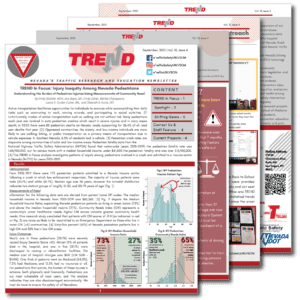 The September 2021 Issue of Nevada’s Traffic Research and Education Newsletter (TREND) contains the following article about Crash and Trauma Outcomes for Motor Vehicle Occupants.
The September 2021 Issue of Nevada’s Traffic Research and Education Newsletter (TREND) contains the following article about Crash and Trauma Outcomes for Motor Vehicle Occupants.
Active transportation facilitates opportunities for individuals to exercise while accomplishing their daily tasks such as commuting to work, running errands, and participating in social activities. Unfortunately, modes of active transportation such as walking are not without risk. Many pedestrians each year are involved in auto-pedestrian crashes which result in severe injuries and in many cases death; in 2020 there were 83 pedestrian deaths on Nevada roads, accounting for 26.4% of all road user deaths that year. Oppressed communities, the elderly, and low-income individuals are more likely to use walking, biking, or public transportation as a primary means of transportation due to vehicle expenses and other reasons. In Southern Nevada, 8.5% of residents lack a vehicle. Pedestrian crash rates are disparate among communities of color and low-income areas. Pedestrian fatality data from the National Highway Traffic Safety Administration (NHTSA) found that nationwide (years 2010-2019) the pedestrian fatality rate was 1.65/100,000, but for census tracts with a median household income under $41,000 the pedestrian fatality rate was over 2.5/100,000.
This TREND in Focus analysis investigates patterns of equity among pedestrians involved in a crash and admitted to a trauma center in Nevada (N=772) for years 2015-2017. For additional details we encourage you to explore the full newsletter at the following link: TREND 10.4, and the simplified visualization of this analysis in Infographic 4.4.

